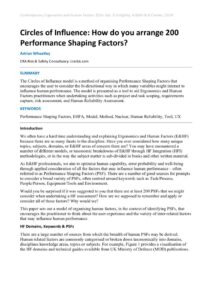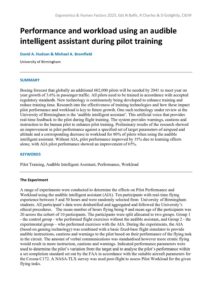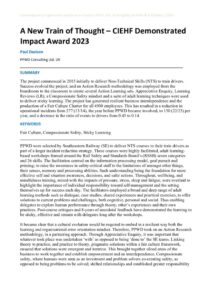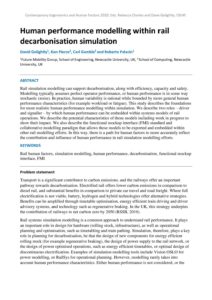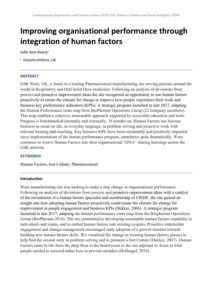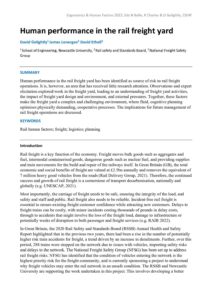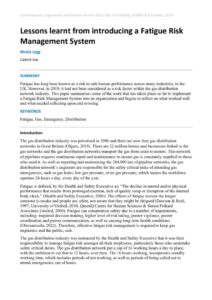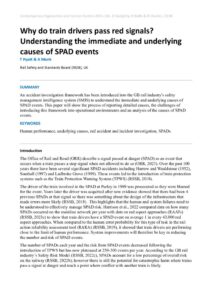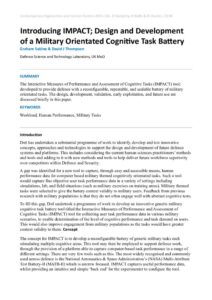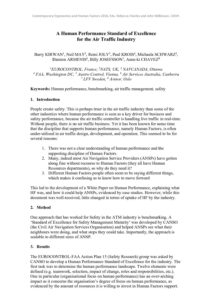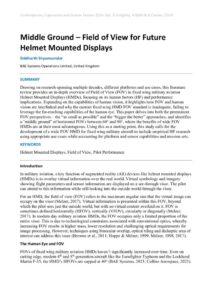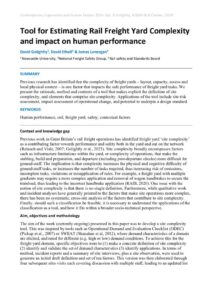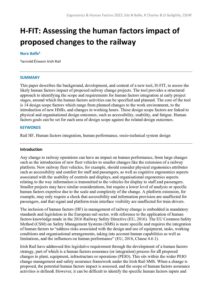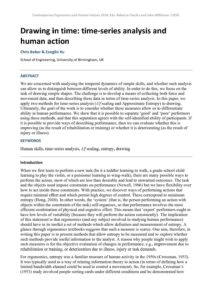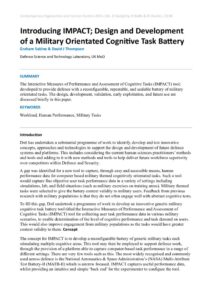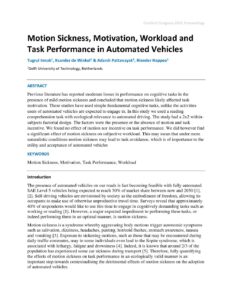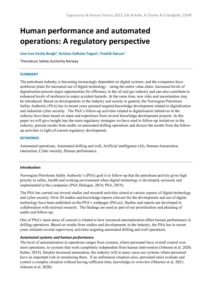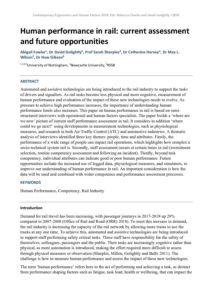Human performance
Circles of Influence: How do you arrange 200 Performance Shaping Factors?
| Document | Author Adrian Wheatley |
| Abstract The Circles of Influence model is a method of organising Performance Shaping Factors that encourages the user to consider the bi-directional way in which many variables might interact to influence human performance. The model is presented as a tool to aid Ergonomics and Human Factors practitioners when undertaking activities such as project and task scoping, requirements capture, risk assessment, and Human Reliability Assessment. |
Performance and workload using an audible intelligent assistant during pilot training
| Document | Author David A. Hudson & Michael A. Bromfield |
| Abstract Boeing forecast that globally an additional 602,000 pilots will be needed by 2041 to meet year on year growth of 3.6% in passenger traffic. All pilots need to be trained in accordance with accepted regulatory standards. New technology is continuously being developed to enhance training and reduce training time. Research into the effectiveness of training technologies and how these impact pilot performance and workload is key to future growth. One such technology under review at the University of Birmingham is the ‘audible intelligent assistant’. This artificial voice that provides real-time feedback to the pilot during flight training. The system provides warnings, cautions and instruction to the human pilot to enhance pilot training. Preliminary results of the research showed an improvement in pilot performance against a specified set of target parameters of airspeed and altitude and a corresponding decrease in workload for 80% of pilots when using the audible intelligent assistant. Without AIA, pilot performance improved by 35% due to learning effects alone, with AIA pilot performance showed an improvement of 65%. |
A New Train of Thought – CIEHF Demonstrated Impact Award 2023
| Document | Author Paul Davison |
| Abstract The project commenced in 2015 initially to deliver Non-Technical Skills (NTS) to train drivers. Success evolved the project, and an Action Research methodology was employed from the boardroom to the classroom to create several Action Learning sets. Appreciative Enquiry, Learning Reviews (LR), a Compassionate Safety mindset and a suite of adult learning techniques were used to deliver sticky learning. The project has generated resilient business interdependence and the production of a Fair Culture Charter for all 4500 employees. This has resulted in a reduction in operational incidents from 277 (13/14), the year before PPWD became involved, to 150 (22/23) per year, and a decrease in the ratio of events to drivers from 0.43 to 0.14. |
Human performance modelling within rail decarbonisation simulation
| Document | Author David Golightly, Ken Pierce, Carl Gamble and Roberto Palacin |
| Abstract Rail simulation modelling can support decarbonisation, along with efficiency, capacity and safety. Modelling typically assumes perfect operator performance, or human performance is in some way stochastic (noise). In practice, human variability is rational while bounded by more general human performance characteristics (for example workload or fatigue). This study describes the foundations for more realistic human performance modelling within simulation. We describe two roles – driver and signaller – by which human performance can be embedded within systems models of rail operations. We describe the potential characteristics of those models including work in progress to show their impact. We also describe the functional mockup interface (FMI) standard and collaborative modelling paradigm that allows these models to be exported and embedded within other rail modelling efforts. In this way, there is a path for human factors to more accurately reflect the contribution and influence of human performance in rail simulation modelling efforts. |
Improving organisational performance through integration of human factors
| Document | Author Julie Ann Avery |
| Abstract GSK Ware, UK, is home to a leading Pharmaceutical manufacturing site serving patients around the world in Respiratory and Oral Solid Dose medicines. Following an analysis of deviations from process and proactive improvement ideas the site recognised an opportunity to use human factors proactively to create the climate for change to improve how people experience their work and business key performance indicators (KPIs). A strategic program launched in late 2017, adapting the Human Performance route map from BioPhorum Operations Group (22 company members). This map enabled a cohesive, measurable approach supported by accessible education and tools. Progress is benchmarked internally and externally. 18 months on, Human Factors has become business as usual on site, in everyday language, in problem solving and proactive work with relevant training and coaching. Key business KPIs have been sustainably and positively impacted since implementation of the human performance program, sometimes quite dramatically. Ware continues to weave Human Factors into their organisational “DNA” sharing learnings across the GSK network. |
Human performance in the rail freight yard
| Document | Author David Golightly, James Lonergan & David Ethell |
| Abstract Human performance in the rail freight yard has been identified as source of risk to rail freight operations. It is, however, an area that has received little research attention. Observations and expert elicitation explored work in the freight yard, leading to an understanding of freight yard activities, the impact of freight yard design and environment, and external pressures. Together, these factors make the freight yard a complex and challenging environment, where fluid, cognitive planning optimises physically demanding, cooperative processes. The implications for future management of rail freight operations are discussed. |
Lessons learnt from introducing a Fatigue Risk Management System
| Document | Author Nicola Legg |
| Abstract Fatigue has long been known as a risk to safe human performance across many industries, in the UK. However, in 2019, it had not been considered as a risk factor within the gas distribution network industry. This paper summarises some of the work that has taken place so far to implement a Fatigue Risk Management System into an organisation and begins to reflect on what worked well and what needed reflecting upon and revising. |
Why do train drivers pass red signals? Understanding the immediate and underlying causes of SPAD events
| Document | Author T Hyat & A Monk |
| Abstract An accident investigation framework has been introduced into the GB rail industry's safety management intelligence system (SMIS) to understand the immediate and underlying causes of SPAD events. This paper will show the process of reporting detailed causes, the challenges of introducing this framework into operational environments and an analysis of the causes of SPAD events. |
Introducing IMPACT; Design and Development of a Military Orientated Cognitve Task Battery
| Document | Author Graham Sabine & David J Thompson |
| Abstract The Interactive Measures of Performance and Assessment of Cognitive Tasks (IMPACT) tool; developed to provide defence with a reconfigurable, repeatable, and scalable battery of military orientated tasks. The design, development, validation, early exploitation, and future use are discussed briefly in this paper. |
A Human Performance Standard of Excellence for the Air Traffic Industry
| Document | Author Barry KIRWAN, Neil MAY, Remi JOLY, Paul KROIS, Michaela SCHWARZ, Damien ARMENIS, Billy JOSEFSSON, Anne-ki CHAVEZ |
| Abstract |
SPAD Dashboard: A tool for tracking and analysing factors influencing SPADs
| Document | Author Nora BALFE, Sean GEOGHEGAN and Brendan SMITH |
| Abstract Signals Passed At Danger (SPAD) continue to be a key risk in railway operations, particularly in areas where safety systems such as TPWS are not yet implemented. This paper discusses the investigation of SPAD events on the Irish railway network and proposes a taxonomy and dashboard for tracking the factors influencing human performance in this context. The dashboard allows the performance shaping factors influencing different error types to be explored and analysed, enabling the development of more effective, systematic recommendations and the communication of human factors to key stakeholders. |
Middle Ground – Field of View for Future Helmet Mounted Displays
| Document | Author Siddharth Shyamsundar |
| Abstract Drawing on research spanning multiple decades, different platforms and use cases, this literature review provides an in-depth overview of Field of View (FOV) in fixed wing military aviation Helmet Mounted Displays (HMDs), focusing on its human factors (HF) and performance implications. Expanding on the capabilities of human vision, it highlights how FOV and human vision are interlinked and why the current fixed wing HMD FOV standard is inadequate, failing to leverage the far-reaching capabilities of the human eye. This paper delves into both the preeminent FOV perspectives – the “as small as possible” and the “bigger the better” approaches, and identifies a “middle ground” of horizontal FOVs between 60° and 90°, where the benefits of wide FOV HMDs are at their most advantageous. Using this as a starting point, this study calls for the development of a wide FOV HMD for fixed wing military aircraft to include empirical HF research using appropriate use cases while accounting for platform and sensor capabilities and mission sets. |
Tool for Estimating Rail Freight Yard Complexity and impact on human performance
| Document | Author David Golightly , David Ethell & James Lonergan |
| Abstract Previous research has identified that the complexity of freight yards – layout, capacity, access and local physical context – is one factor that impacts the safe performance of freight yard tasks. We present the rationale, method and contents of a tool that makes explicit the definition of site complexity, and elements that comprise site complexity. Applications of the tool include site risk assessment, impact assessment of operational change, and potential to underpin a design standard. |
Understanding human behaviour and decision-making at level crossing
| Document | Author Katherine L. Plant, Richard Bye, Katie J. Parnell, Craig K. Allison, Jade Melendez, Neville A. Stanton |
| Abstract This work presents a collaboration between [an academic] and [industry partner] to help improve safety at level crossings by developing a deeper understanding of how people behave at them. Using the theoretical foundations of the Perceptual Cycle Model (Neisser, 1976) to generate behavioural insights from workshops, interviews and field observations, the work aims to create decision support tools for level crossing managers, engineers, safety teams and investigators. The resulting human factors toolkit will inform hazard analysis, system design and behavioural interventions that will put level crossing users—and their needs, goals and behaviours—at the centre of activities to improve system safety. |
H-FIT: Assessing the human factors impact of proposed changes to the railway
| Document | Author Nora Balfe |
| Abstract This paper describes the background, development, and content of a new tool, H-FIT, to assess the likely human factors impact of proposed railway change projects. The tool provides a structured approach to identifying the scope and requirements for human factors integration at early project stages, around which the human factors activities can be specified and planned. The core of the tool is 14 design scope factors which range from planned changes to the work environment, to the introduction of new HMIs, and changes in working hours. These design scope factors are linked to physical and organisational design outcomes, such as accessibility, usability, and fatigue. Human factors goals can be set for each area of design scope against the related design outcomes. |
Exploring workload and performance through the use of visual analytics
| Document | Author Joanne Kitchin & Chris Baber |
| Abstract In Visual Analytics, the output of automated analysis is presented to users in an interactive visualisation. By responding to this, the user can modify the parameters of the computer visualisation. This raises questions about the design of the visualisation and the appropriate level of interaction for users. This paper focuses on the impact of visualisation on user performance. A simple air target detection task (in which automated support identified possible threat aircraft) was combined with a secondary task (in which target letters had to be detected against a background). Four visual analytic displays were used to complete a target detection task over two studies. The first study explored how the displays affected workload, attentional demand and performance, and the second how workload, attentional demand and performance are affected by task load (using the same displays). Results show that the use of visual analytic displays maintains response time and primary task performance when task load increases. This suggests that the demand on attention is easier to manage when visual analytic displays are used. |
Drawing in time: time-series analysis and human action
| Document | Author Chris Baber & Zonglin Xu |
| Abstract We are concerned with analysing the temporal dynamics of simple skills, and whether such analysis can allow us to distinguish between different levels of ability. In order to do this, we focus on the task of drawing simple shapes. The challenge is to develop a means of collecting both force and movement data, and then describing these data in terms of time-series analysis. In this paper, we apply two methods for time-series analysis (1/f scaling and Approximate Entropy) to drawing. Ultimately, the goal of the work is to consider whether these measures allow us to differentiate ability in human performance. We show that it is possible to separate ‘good’ and ‘poor’ performers using these methods, and that this separation agrees with the self-identified ability of participants. If it is possible to provide ways of describing performance, then we can evaluate whether this is improving (as the result of rehabilitation or training) or whether it is deteriorating (as the result of injury or illness). |
Participatory Ergonomics The design of PRIME Road Markings for Motorcycle Casualty Reduction
| Document | Author Graham Sabine & David J Thompson |
| Abstract The Interactive Measures of Performance and Assessment of Cognitive Tasks (IMPACT) tool; developed to provide defence with a reconfigurable, repeatable, and scalable battery of military orientated tasks. The design, development, validation, early exploitation, and future use are discussed briefly in this paper. |
Motion Sickness, Motivation, Workload and Task Performance in Automated Vehicles
Human performance and automated operations: A regulatory perspective
| Document | Author Linn Iren Vestly Bergh, Kristian Solheim Teigen & Fredrik Dørum |
| Abstract The petroleum industry is becoming increasingly dependent on digital systems, and the companies have ambitious plans for increased use of digital technology – along the entire value chain. Increased levels of digitalisation present major opportunities for efficiency in the oil and gas industry and can also contribute to enhanced levels of resilience to major accident hazards. At the same time, new risks and uncertainties may be introduced. Based on developments in the industry and society in general, the Norwegian Petroleum Safety Authority (PSA) has in recent years pursued targeted knowledge development related to digitalisation and industrial cyber security. The PSA’s follow-up activities related to digitalisation initiatives in the industry have been based on input and experience from several knowledge development projects. In this paper we will give insight into the main regulatory strategies we have used to follow-up initiatives in the industry, present results from audits on automated drilling operations and discuss the results from the follow-up activities in light of current regulatory development. |
Human performance in rail: current assessment and future opportunities
| Document | Author Abigail Fowler, Dr David Golightly, Prof Sarah Sharples, Dr Catherine Harvey, Dr Max L. Wilson, Dr Huw Gibson |
| Abstract Automated and assistive technologies are being introduced to the rail industry to support the tasks of drivers and signallers. As rail tasks become less physical and more cognitive, measurement of human performance and evaluation of the impact of these new technologies needs to evolve. As pressure to achieve high performance increases, the importance of understanding human performance limits also increases. This paper on human performance in rail is based on semi-structured interviews with operational and human factors specialists. The paper builds a ‘where are we now’ picture of current staff performance assessment in rail. It considers in addition ‘where could we go next?’ using developments in measurement technologies, such as physiological measures, and research in both Air Traffic Control (ATC) and automotive industries. A thematic analysis of interviews identified three key themes: people, time and attributes. Firstly, the performance of a wide range of people can impact rail operations, which highlights how complex a socio-technical system rail is. Secondly, staff assessment occurs at certain times in rail (recruitment selection, routine competency assessment and following an incident). Thirdly, beyond task competency, individual attributes can indicate good or poor human performance. Future opportunities include the increased use of logged data, physiological measures, and simulators, to improve our understanding of human performance in rail. An important consideration is how the data will be used and combined with wider competence and performance assessment processes. |

